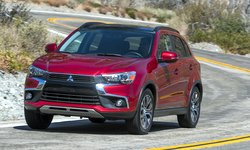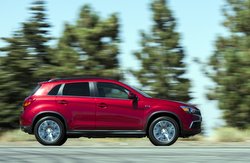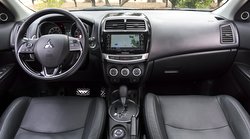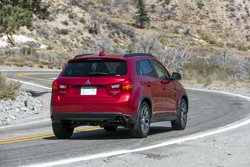Mitsu Best-Seller—Maybe the Best Buy
Mitsubishi’s subcompact Outlander Sport crossover SUV is the automaker’s best-selling vehicle in the U.S. Smaller than the Outlander that I reviewed a few days ago, the ES base trim starts at a very thrifty $19,795 (plus $895 destination charges), which is $3,700 less than the three-row Outlander ES.
For many shoppers, the best feature of the 2017 Mitsubishi Outlander Sport will be its price tag. And while other compact SUVs offer a sub-$20,000 model, they won’t come with standard auto climate control and a 10-year/100,000-mile powertrain warranty. Even a nicely equipped top-of-the-line GT with all-wheel drive barely touches the $30,000 zone.

Following in its big brother’s footsteps, the Outlander Sport is offered in ES, SE, SEL and GT trim levels. Each trim is available with either front- or all-wheel drive. Not typical, the base ES is offered with a five-speed manual transmission. All other models come standard with a continously-variable transmission (CVT). For motivation, the base ES is equipped with a 2.0-liter four-cylinder, while the balance of the lineup is standard with a more powerful 2.4-liter four.
Fuel economy plays a part in the decision to buy most vehicles, and the Outlander Sport offers good, but not great numbers. The EPA estimates fuel economy for the 2.0-liter engine with the manual transmission and front-wheel drive at 23 miles per gallon city/29 mpg highway/25 mpg combined. With the CVT, it’s 24 mpg city/30 mpg highway/27 mpg combined. Adding optional all-wheel drive (which requires the CVT and is called all-wheel control by Mitsubishi) results in 23 mpg city/29 mpg highway/26 mpg combined. It’s all a shade under Clean Fleet Report’s goal of 30 mpg for all-wheel drive vehicles, although as you’ll see later, it looks like an experienced drive could top 30 mpg on the highway.
Moving up to the larger powerplant is a small fuel economy penalty with front-drive models returning 23 mpg city/28 highway/25 combined, according to the EPA. All-wheel drive versions see 22 mpg city/27 highway/24 combined.
Underneath The Sheetmetal
For get-up-and-go, the 2017 Mitsubishi Outlander Sport relies on the same two engines it started with in 2011. The base is a forgettable aluminum block 2.0-liter four that puts out a whimpering 148 horsepower and 145 pounds-feet of torque. It’s overwhelmed by the 3,200-pound weight of the crossover. Unless most of your driving is on flat city streets, I don’t recommend this engine.

Instead, get the available 2.4-liter four-cylinder. At 168 horsepower, it’s no powerhouse, but it doesn’t have to work as hard to get the Outlander Sport moving, It’s quieter as well as offering more punch. The CVT mimics a standard transmission with “shift” points, and is fairly smooth. Opt for the SEL or GT trim and you’ll find paddle shifters that make up or downshifts convenient.
All-wheel drive traction is courtesy of Mitsubishi’s S-AWC system, an acronym for Super All Wheel Control. It automatically directs power rearward whenever the front wheels begin slipping, offering peace of mind on rain-slicked roads as well as snow-covered highways. While the S-WAC stystem doesn’t turn the Sport into a potent off-roader, it can lock all four wheels for added low-speed traction. The 8.5-inch ground clearance makes it an acceptable vehicle for Forest Service trails and roads.
The Outlander Sport uses the same suspension setup as the larger Outlander — a MacPherson strut layout in front with a trailing multi-link at the rear. This configuration delivers a smooth ride quality, but falls short when it comes to handling dynamics.
Stands Apart From the Crowd
One year removed from a styling refresh, the 2017 Mitsubishi Outlander Sport unabashedly stands out from the large group of cookie-cutter crossovers with a distinct SUV appearance that’s in tune with a new design direction called “Dynamic Shield”. There’s simple chrome detailing on the new grille and window line, and a rising character line that reaches from the front wheel arch to the back of the rear doors to break up the slab-sided look. The proportions are spot-on and, with standard 18-inch wheels, it’s an aggressive design that looks good.
The Outlander Sport’s interior won’t grab any design awards, but beautiful interior designs don’t always place the controls in intuitive places. My test SEL cabin may not have been high art, but the controls were all pretty much where you’d want them to be and easy to understand. The hooded speedometer and rev counter featured crisp white backlighting and numerals that were easily read at a glance. The interior was complemented by piano-black accents, bright trim around the center stack and a 6.1-inch display audio system.

As for the materials themselves, everything I touched felt on the cheap side, but nothing felt flimsy. The quality of the plastics wasn’t bargain bin, and nothing felt liable to break, but at the same time, it was pretty clear that materials quality trailed the competition.
Comfortable front seats were supportive over a long drive, and the accommodating back seat is a pleasant surprise. Despite this crossover’s compact dimensions, adults should have no problem getting comfortable in the second row. As for those with little ones, there’s minimal effort to install two car seats.
The interior of the 2017 Mitsubishi Outlander Sport looks larger than it actually is. It’s practical, with a low loading cargo floor and split-folding rear seat backs. Open the rear hatch and you’ll find 21.7 cubic feet of cargo space, which is more room than many of its competitors offer. Fold the rear seats down, and this area expands to 49.5 cubic feet.
The base Mitsubishi Outlander Sport ES offers some solid features for its roughly $20,000 price, including leather-wrapped steering wheel and shift knob, automatic climate control, steering-wheel-mounted cruise control and audio buttons, a four-speaker/140-watt AM/FM/CD system, LED taillights and 18-inch alloy wheels.
Our SEL with all-wheel drive brought keyless entry, fog lights, power-folding mirrors, a rearview camera, heated front leather seats, an eight-way power-adjustable driver’s seat, steering-wheel-mounted gearshift paddles, a 6.1-inch touchscreen compatible with Apple CarPlay and Android Auto and a six-speaker audio system with satellite radio. The out-the-door price totaled $26,590.
Safety systems included hill-start assist, stability control, anti-lock disc brakes and seven standard airbags, plus a driver’s-side knee airbag. However, it offers no advanced driver assists, which typically include things like blind spot monitoring and adaptive cruise control.
On the Road
A tilt/telescoping steering column, along with the power height adjustment, made easy work of finding a comfortable driving position in our 2017 Mitsubishi Outlander Sport SEL. Exceptional outward visibility and sight lines made it an easy car to drive on the freeway, in urban environments and crowded shopping mall parking lots.
Several competitors offer higher horsepower and torque numbers, but I found the 2.4L engine to be more than adequate for the task of motivating the 3,200 pound cute-ute. I did find that, at 9.5 seconds, the 0 to 60 mph sprint wasn’t much of an adrenaline rush.

Overall, I was—and think most folks will be—pleased with the engine. It wasn’t a barn-burner, but the car accelerated quickly enough for anxiety-free freeway merging, However, passing on two-lane roads required cautionary thinking. When hard, quick acceleration was needed, the engine felt a little sluggish, and the raucous drone created by the CVT was loud and annoying.
Although the 2017 Mitsubishi Outlander Sport doesn’t offer a sport-tuned suspension, it does have steering wheel mounted paddle shifters. The driver can activate manual shifting by touching one of the paddles (right for up-shifts, left for down-shifts). It will hold a down-shift when rounding a tight curve or when traffic ahead begins to slow.
The Sport’s suspension goes the middle road between firmness and comfort. It provided a controlled ride on the highway and smoothed out problems on the road, keeping its composure quite well on rough pavement while dealing with potholes in typical small car fashion—jarring at times.
Mitsubishi’s electric-assisted power steering is better than most. It’s light, yet accurate and responsive overall, and the car feels competent when changing direction.
You can erase the word “sport” from your mind. The Oulander Sport is not a carve-the-corners, athletic small crossover, and it doesn’t try to be one.
When Mitsubishi delivered the Outlander Sport, the fuel mileage readout was an even 24 mpg, the EPA’s estimated number. Our week of driving was fairly reflective of an average owner—a long freeway trip, in-town stop-and-go traffic and a leisurely Sunday afternoon drive in the country. After adding our 327 miles to the odometer, the pint-size crossover yielded 27.3 mpg, more than the EPA’s combined estimate.
In the Marketplace
For many shoppers, the best feature of the 2017 Mitsubishi Outlander Sport will be its price tag. Other compact SUVs offer a sub-$20,000 model, but they won’t come with standard auto climate control and a 10-year/100,000-mile powertrain warranty. Even a nicely equipped top-of-the-line Outlander Sport GT with all-wheel drive barely touches the $30,000 zone.
Despite the Outlander Sport’s low price and great warranty, there are a number of all-star competitors that are much newer. Like the Mazda CX-3, which pleases with a zippy engine and superb handling. If fuel economy is a priority, Honda’s HR-V will hit the spot, plus its versatile rear seat can fit passengers just as well as it can fit a big-screen TV. For off-road enthusiasts, a little ruggedness is cool with Jeep’s Renegade. And then there’s the charming and affordable Fiat 500X. The list keeps growing, including the Nissan Juke, Chevrolet Trax and newcomers like the Ford EcoSport and Toyota CH-R.
In the end, value is an eye-of-the-beholder metric. Buyers on limited budgets seeking escape through the maze of small crossovers will find much to like about the 2017 Mitsubishi Outlander Sport. And note, with a new Outlander Sport coming later this year, dealers will be willing to, well, deal on the already low price.
Test price (and drive) the Outlander Sport.
Related Stories You Might Enjoy:
Road Test: 2017 Mitsubishi Outlander
Road Test: 2017 Mazda CX-3
Road Test: 2016 Honda HR-V (John’s view)
Road Test: 2016 Honda HR-V (Larry’s view)
First Drive: 2015 Jeep Renegade
Road Test: 2016 Fiat 500X
Road Test: 2015 Nissan Juke
Road Test: 2015 Chevrolet Trax
Disclosure:
Clean Fleet Report is loaned free test vehicles from automakers to evaluate, typically for a week at a time. Our road tests are based on this one-week drive of a new vehicle. Because of this we don’t address issues such as long-term reliability or total cost of ownership. In addition we are often invited to manufacturer events highlighting new vehicles or technology. As part of these events we may be offered free transportation, lodging or meals. We do our best to present our unvarnished evaluations of vehicles and news irrespective of these inducements.
Our focus is on vehicles that offer the best fuel economy in their class, which leads us to emphasize electric cars, plug-in hybrids, hybrids and diesels. We also feature those efficient gas-powered vehicles that are among the top mpg vehicles in their class. In addition, we aim to offer reviews and news on advanced technology and the alternative fuel vehicle market. We welcome any feedback from vehicle owners and are dedicated to providing a forum for alternative viewpoints. Please let us know your views at publisher@cleanfleetreport.com.

2 thoughts on “Road Test: 2017 Mitsubishi Outlander Sport”